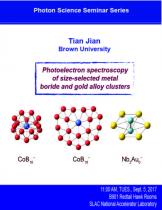Speaker: Tian Jian, Brown University
Program Description
The study of clusters can facilitate the discovery of novel structural motifs, reveal unusual chemical bonding, and lead to the rational design of new materials with tailored properties. This talk focuses on our recent progresses on size-selected metal boride and gold alloy clusters. Due to the electron deficiency of boron, elemental boron and its compounds exhibit unusual structures and chemical bonding. Metal-doping can significantly expand the potential nanostructures based on boron. A family of transition-metal-centered boron molecular drums have been observed, setting a record of coordination number to twenty. The recent discoveries of planar boron clusters CoB18− and RhB18− suggest the exciting possibility of metallo-borophenes, which represent a new class of 2D materials with tunable chemical and physical properties. Very recently, the first experimental observation of Bi-B triple bond in BiB2O− cluster paves the way toward future synthesis of chemical compounds with metal-boron triple bonds. Two interesting gold alloy clusters are also investigated, revealing novel bond-bending isomerism and metal-ligand bonding.





